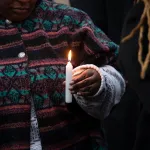We’re answering the “how” and “why” of LGBTQ+ news. Subscribe to our daily newsletter.
A death certificate files the most basic snapshots of a person’s life into a series of boxes. This last official record leaves much uncaptured about how a person truly lived and how they’ll be remembered. For transgender people, the unrecorded carries even deeper implications: The loss of their identity within that document is literal.
Without updated identity documents, such as a driver’s license or other government-issued I.D., trans people are likely to be misgendered and have the wrong name on their death certificates — in spite of their lived experience, gender expression or physical transition. That acute loss of self weighs heavily on the minds of many trans people, especially those with unsupportive families or those without resources to change their documentation.
The potential for one’s true self to be discounted after death is especially troubling for a community that endures high rates of violence, as memorialized each year on the Transgender Day of Remembrance. Many of the trans people killed each year are misgendered in police statements and media reports.
A lack of demographic death data across the board on LGBTQ+ people means that knowing how many trans people are misgendered after death, or even how many transgender people die in the United States each year, is not possible. In addition to erasing trans identities, that absence of data means crucial public health efforts cannot be tailored to address disparities affecting LGBTQ+ people, experts tell The 19th.
The paperwork, policies and software used to record death vary from state to state. Without state or federal requirements to gather LGBTQ+ data after death, crucial choices on the remembrance of deceased transgender people are left in the hands of individual funeral directors, medical examiners and death investigators working within a convoluted and underfunded system.
However, one recent study was able to take a rare look into how many trans people had been misgendered after death within the Portland, Oregon, metro area.
Of the 47 trans and nonbinary people who died from 2011 to 2021 that researchers could find, more than half had their genders marked incorrectly on their death certificates. That number was small — 29 trans people over that 10-year period were misgendered on their death certificates. But the time-consuming manner that researchers had to use to prove even that sliver of information underlines the key problem: For Oregon and most other states, there is no formal record of someone’s gender identity after death at all.
Kimberly Repp, co-author of the study and chief epidemiologist in Washington County’s medical examiner’s office, believes their research points to a national problem of trans people being ignored after death. That “nonconsensual detransitioning after death,” as Repp and her co-authors describe it, was hard for them to stomach.
“There was a lot of angry crying from all three of us when we were doing this. Just, sick to your stomach, wanting to puke from anger and sadness,” said Repp. In her work, she has been to many death scenes in person — which means staying professional, no matter what happens in an emotionally volatile space. But collecting data in this study affected Repp in a new way.
“I’m a privileged, cis, White female, I’m not living this. I can’t even imagine what it’s like to have to live with this happening and be just erased with this level of violence,” she said.
The last time Repp went out in the field was before the start of the COVID-19 pandemic. Around 2018 or 2019, she remembers having to tame her anger as she watched a family misgender their transgender child following their suicide.
“I can’t ever say anything, but I see, here in this community, what happens. People are just ‘poof,’ their whole lives as they have lived them is switched by one vindictive person. And it should never be that way for anyone,” Repp said.
Stephanie Byers, the first out trans representative in Kansas, has witnessed this kind of erasure firsthand. In 2021, she learned that someone from her past life as a high school band director had come out as trans. Byers reached out. Through conversations on social media and over the phone, Byers learned that she had inspired the former band director, Donna, to come out and live as herself. They planned to meet for coffee. Then Donna died. Her sons misgendered her in her obituary and on social media — and everywhere else, Byers said.
People are just ‘poof,’ their whole lives as they have lived them is switched by one vindictive person. And it should never be that way for anyone.
Kimberly Repp
“And here this person had just found that courage, at 61, I believe she was, to express herself. To see it stripped away. But what right does she have after she’s gone?” Byers said.
Lawmakers should create policy to ensure transgender people can be recognized as their true selves after death if they lack updated identity documents, Byers said — especially since the process of obtaining those documents can be difficult in some states. Byers has updated her Kansas driver’s license and her passport, but she hasn’t yet been able to change her Oklahoma birth certificate.
“I’m confident that if something were to happen to me, that my sons would bury me as I am,” she said. “How do we ensure that for everybody else? I think that in conservative states, that becomes a real difficult issue.”
Byers will leave office this month after declining to run for reelection, to help take care of her wife’s aging parents. And although she wants to see these changes take place, she also believes — based on her own experience in Kansas’ state legislature and the current atmosphere on trans rights in conservative-led statehouses — that it may be difficult, or even impossible, to put such changes around death certificates into law right now.
A few times a year, the medical examiner’s office within Utah’s department of health will record the violent or unexpected death of a transgender person, according to Michael Staley, who has worked in the office for five years. But if their legal record hasn’t been updated from their sex assigned at birth, the sex listed on their death certificate will not reflect their true gender identity.
“On a death certificate, we’re pretty much bound to use the information that matches the identification,” he said. Their office will use whatever gender marker a trans person has updated their government-issued documentation with, regardless of their physical appearance or disputes from family members, Staley said. It is rare that he’s seen a family push back against a deceased transgender person’s true gender identity.
Staley, who tracks suicide data in Utah and investigates unclear deaths under the chief medical examiner, said that he and his colleagues try to avoid misgendering trans people in death records whenever possible — even when they are legally bound to do so on a death certificate.
During his time in the Utah medical examiner’s office, reports created by the department have still used correct pronouns for deceased transgender men and women, even when their death certificates cannot reflect their true gender (or when families take issue with the report acknowledging the deceased person’s transgender identity).
As far as Staley knows, there is no written policy for how the state medical examiner’s office handles such cases.
“We don’t want to misgender somebody in their death when everything tells us that’s true, even if the family is pushing back against that,” he said. “We want to honor the person who died and reference them as they would [have] wanted to be referenced when they were alive, wherever and whenever we legally can.”
In June 2021, local death investigators — most of whom are called into the field sporadically and aren’t full-time, due to limited demand in Utah — received a two-day, in-person training that included a lecture on how to collect information about a deceased person’s sexual orientation and gender identity. The training, hosted by Utah’s office of the medical examiner, was co-organized by John Blosnich, assistant professor and director of the University of Southern California’s Center for LGBTQ+ Health Equity, and done by Barbara Butcher, who worked as a death investigator for the New York City medical examiner’s office for just over two decades.
We want to honor the person who died and reference them as they would [have] wanted to be referenced when they were alive, wherever and whenever we legally can.
Michael Staley
“Salt Lake City was a tough crowd. A very tough crowd,” Butcher said. She remembers a split group of death investigators: young women who asked pointed, knowledgeable questions, those in attendance who were slightly skeptical but willing to listen, and a few men who were disengaged during the lecture, sitting with arms crossed or baseball caps over their eyes.
Staley believes the June 2021 training got more people in the office to be aware of the issue — but said there are still a lot of people who struggle to find how to ask someone, soon after their family member’s death, about someone’s LGBTQ+ identity.
The kind of training that those Utah death investigators received is rare. It’s also just one step out of many needed to fix the absence of LGBTQ+ demographic data collected after death. To record someone’s gender identity in Utah during a death investigation, like in other states, it must be written out in a narrative format by the investigator — there is no designated box.
“I think this is an issue that we’re not going to be able to solve with a training. I think that was the beginning of the conversation,” Staley said. Another step towards more data may be in sight: Staley hopes that, within the next 18 months, the software Utah uses to record violent and unexplained deaths will be updated to track gender identity and sexual orientation.
Repp has experienced a similar firewall in Oregon. MDILog, the case management software used by Oregon to record death investigation data, has no options to record gender identity, outside of a separate form if someone dies by suicide. She hopes their latest research will help convince MDILog to add options for tracking whether those deceased are transgender.
The way people are accounted for and processed after death — in funeral homes, on death certificates, and through medical examiners and death investigators in violent or unexpected deaths — the whole death system itself needs to be changed, Repp said.
“I look at this for transgender individuals or nonbinary individuals, they’re erased. There’s nothing in here, in the entire system, top to bottom, that’s incorporating that as a possibility,” Repp said. “With sex and gender, we’re still in the Dark Ages.”
As far as Blosnich knows, and as he and Butcher found in a 2019 study undertaken with the help of a working group that included staff from the Centers for Disease Control and Prevention, gender identity and sexual orientation at time of death are not comprehensively tracked anywhere in the country. The CDC has tried to encourage the collection of such data for violent deaths by adding LGBTQ+ categories to its National Violent Death Reporting System, a database drawn from death certificates, medical examiner’s reports and other points in the country’s death system — but states aren’t required to provide that information. Last year, California launched a pilot program, reportedly the first of its kind in the country, to allow six counties to track victims’ sexual orientation and gender identity in violent deaths.
With sex and gender, we’re still in the Dark Ages.
Kimberly Repp
That missing data matters because, without it, experts have less concrete information on which to base mitigation efforts for public health issues that disproportionately harm LGBTQ+ people — like higher rates of attempted suicide and substance abuse. Data gleaned through death investigations is uniquely positioned to provide near real-time information on those issues, because it’s reported within days of a death taking place, depending on the state. But in most cases, that data on LGBTQ+ deaths just isn’t there.
Death certificates, which feed data into the National Center for Health Statistics that undergirds the country’s public health infrastructure, are a more universal problem. Not tracking gender identity on this key legal document — which is needed to collect life insurance or to close the bank account of the deceased — affects a greater number of people. Transgender people who die of natural causes in a medical setting, whose death will not be investigated, are still misgendered on their death certificates.
“Whether you die naturally in a hospital, or you experience a violent death, the same piece of paper is filled out with the same choices, and those choices are not acceptable,” Repp said.
A few states have taken action. In 2021, California Governor Gavin Newsom signed a bill adding a “nonbinary” option to death certificates, and Illinois reportedly put the same policy into place. Oregon added a similar option to death certificates in 2018, and New York City followed suit in 2019. In 2015, a California law went into effect requiring death certificates to reflect the decedent’s gender identity, based on updated gender markers — or on proof of medical treatment for a gender transition.
Researchers and experts working in medical examiners’ offices want more progress to be made, although not all of them agree on whether death certificates themselves should be changed — or if such a change is realistic.
Repp and her colleagues believe that death certificates should be federally required to have gender markers other than male, female and unsure — which describes unidentified human remains rather than gender — and that laws to ensure that decedents’ gender identity is recorded passed at state and federal levels.
When transgender people are misgendered on their death certificate, they’re being lost in the data — and their legacy is being altered through an official document that will misgender them for the rest of their remembrance, Blosnich said. And having LGBTQ+ demographic information captured on a death certificate would allow researchers to learn about non-violent deaths that disproportionately affect queer people. However, he does not believe the country’s death system is ready for a sweeping change in death certificates.
“I do not think we are at a place in this country where the death certificate should include sexual orientation and gender identity,” he said. Funeral directors can help next of kin complete death certificates, and physicians are tasked with completing them too — alongside medical examiners and coroners. Changing the form would require large-scale training on what the demographic data is and how to collect it, he said, and he worries that state legislatures passing anti-LGBTQ+ bills would block efforts to change death certificates.
Olivia Hunt, policy director at the National Center for Transgender Equality (NCTE), said that the organization hopes to see improvement over the next few years to the disjointed system that trans people are subjected to via death certificates.
“We’re used to seeing a patchwork in every state, county by county, on how name changes will work or state by state how birth certificates and driver’s licenses will work. But death certificates are an unusual situation,” she said. Individual funeral directors and death investigators have to make decisions within a system that was not designed with trans people in mind, she said.
NCTE plans to spend more time on policy advocacy around death certificates and how transgender people are accounted for after death, through outreach to newly elected governors and state legislators, Hunt said.
Being misgendered after death is something that weighs on the minds of a lot of transgender people, Hunt said. It makes her think of a scene from Neil Gaiman’s early 1990s graphic novel “The Sandman,” where the friend of a trans woman writes her friend’s true name in lipstick on her gravestone.
“That’s an image that has haunted me for most of my life, ever since I read that. And it’s really sad that that’s still an issue in so many trans people’s lives.”







